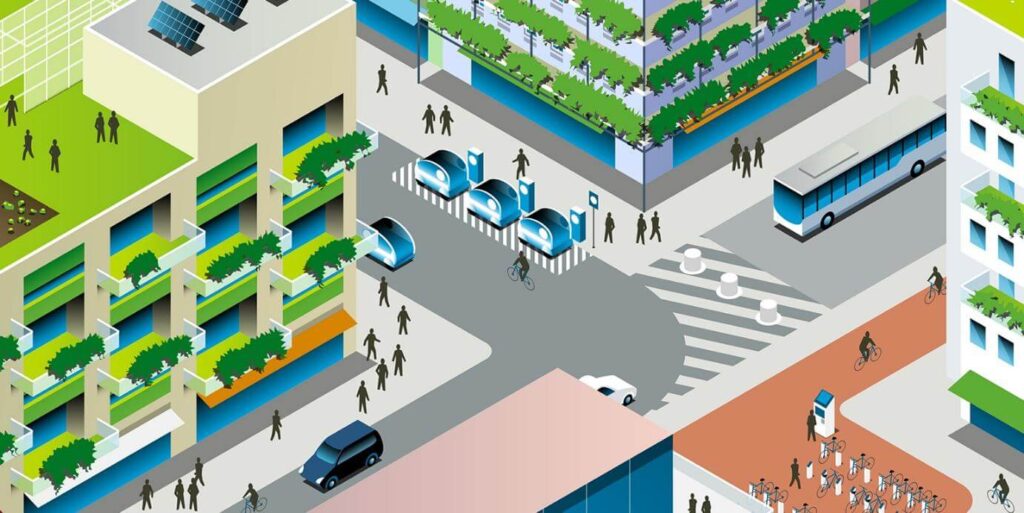Which pollutants are released into the air by traffic?
Car traffic and the resulting exhaust gases emit gases such as carbon dioxide (CO2) and nitrogen dioxide, which are classified as strong respiratory poisons. In addition, carbon monoxide and sulphur dioxide are also released, which irritate the respiratory tract and lungs. All these gases also contribute to climate change. To simplify calculations, they are converted into CO2 equivalents.

In addition, fine dust particles are released into the air through exhaust gases and the abrasion of tyres and brakes. But what actually is fine dust?
Fine dust is, as the name suggests, extremely fine dust, so fine that it is invisible to the naked eye. Fine dust is categorised according to its size. These include PM10, which includes dust particles with a diameter of less than 10 micrometres (10 µm = 0.01 mm), and PM2.5, which have a diameter of less than 2.5 micrometres (2.5 µm = 0.0025 mm). Although fine dust is not visible, it is almost always present in our everyday lives.
A report by the Federal Environment Agency on PM10 mentions that the proportion of the population exposed to PM10 concentrations above the World Health Organisation (WHO) guideline values between 2010 and 2021 has decreased from 90.5% to 20.3%. This is positive news, but a fifth of the population still remains above the guideline value.
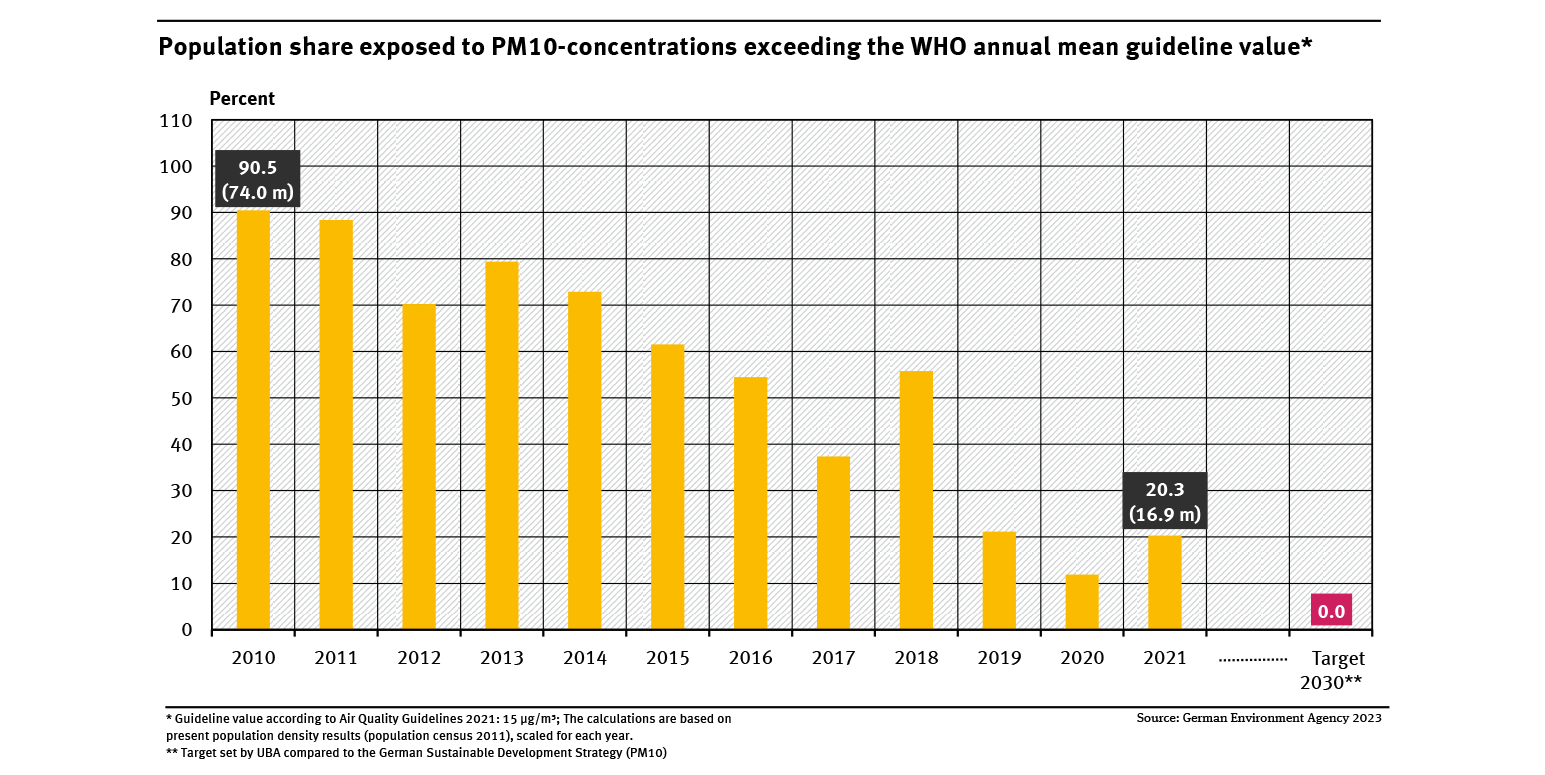
In the report on PM2.5 the situation is unfortunately less favourable. It reports that almost the entire population was exposed to PM2.5 concentrations exceeding the WHO guideline values for the same period.

Effects of fine dust on our health
Fine dust is a serious problem because it has been scientifically proven to cause health problems. The Federal Environment Agency reports that fine dust is already a health risk in itself. However, it can become even more dangerous if pollutants such as heavy metals are present on the surface of the fine dust particles. These pollutants enter our bodies through the fine dust.
The health risk also increases the smaller the particles are. This is because the smaller particles enter the human body more easily and more deeply. While coarser fine dust is usually caught in the nose, smaller particles can penetrate deep into the lungs, reaching the bronchi, bronchioles and air sacs. Ultra-fine particles, which are smaller than 100 nanometres, can even penetrate the cellular level of the lungs and enter the blood or lymphatic system. Smaller particles also have a lower chance of being exhaled again. From a health perspective, PM2.5 poses a greater threat than PM10.
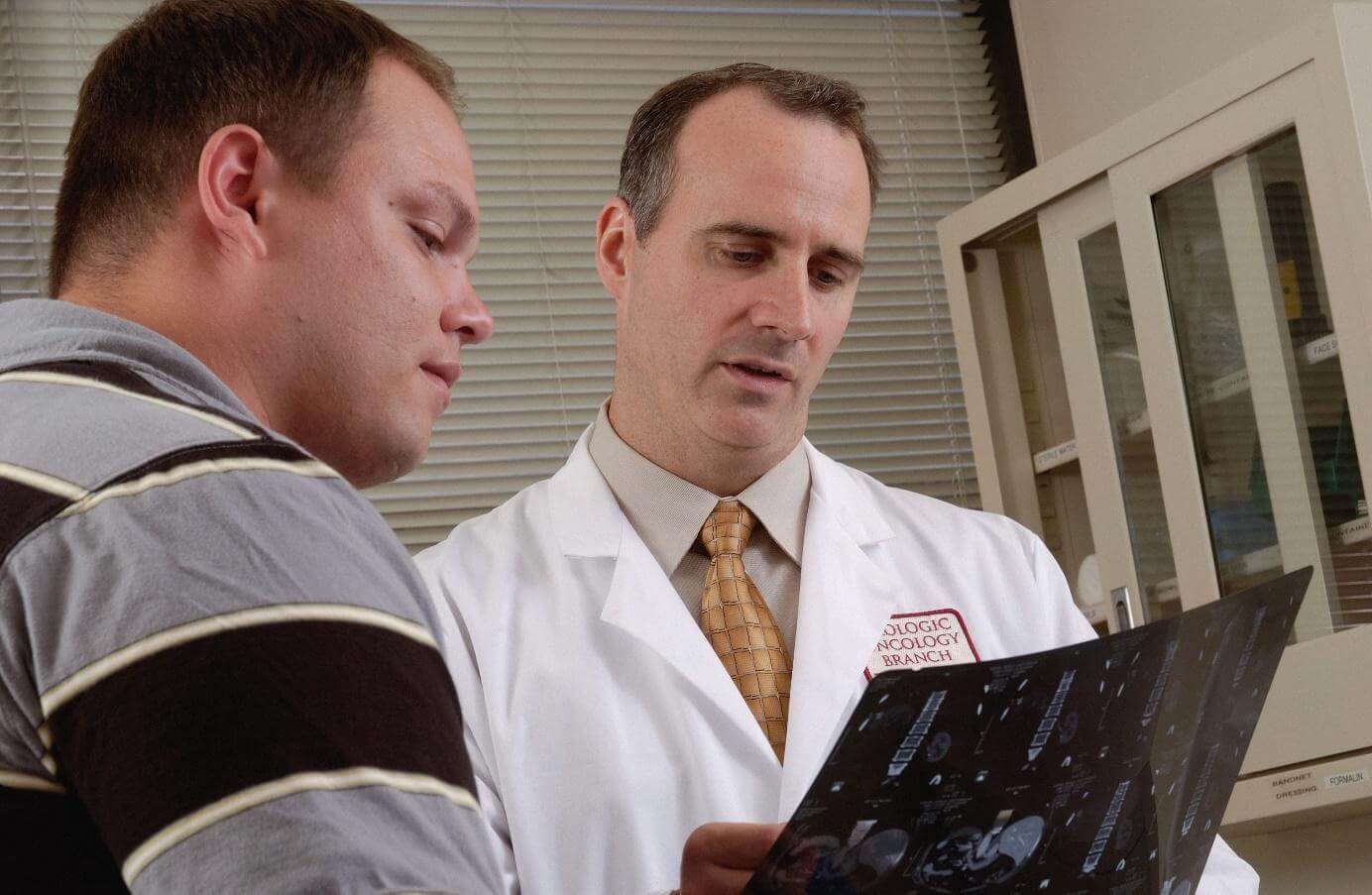
But how exactly does fine dust lead to health problems? According to the Federal Environment Agency, fine dust does this by triggering inflammation and stress in human cells. If this happens over a long period of time, serious health issues can arise. With continued exposure over months and years, complications can develop in various body systems, including the respiratory system (such as asthma, reduced lung growth, bronchitis, lung cancer), the cardiovascular system (such as arteriosclerosis, high blood pressure, blood clotting), the metabolism (such as type 2 diabetes mellitus) and the nervous system (such as dementia). Short-term, intensive exposure (over hours or days) leads to high blood pressure, cardiac arrhythmia and increased hospitalisation, usually due to cardiovascular diseases.
The effects of fine dust can be wide-ranging. However, it is undeniable that fine dust leads to increased mortality. Children, the elderly and people with pre-existing respiratory conditions are particularly at risk as they are exposed to higher levels.
In order to minimise harmful effects on health, it is crucial to keep fine dust pollution as low as possible. The World Health Organisation (WHO) has established in studies that there is no concentration of PM10 and PM2.5 below which harmful effects on health can be completely excluded.
Traffic and climate change
That is all about fine dust, but there are also greenhouse gases. Car traffic contributes significantly to climate change, mainly through the emission of CO2. Other resulting greenhouse gases are converted into CO2 equivalents. In order to mitigate climate change, climate protection targets have been set for the transport sector in Germany. According to the Federal Climate Change Act, greenhouse gas emissions from transport must be reduced to 84 million tonnes of CO2 equivalents by 2030, which represents a reduction of almost 50 percent compared to 2019. According to the Climate Change Act, Germany must become greenhouse gas neutral by 2045, which will probably require the transport sector to reduce its greenhouse gas emissions to zero.
A report by Deutschlandfunk shows that although emissions from the transport sector in Germany were reduced by 18% between 2000 and 2021, this reduction would now have to be doubled in order to achieve the climate targets for 2030. In 2021, total emissions in Germany amounted to 148 million tonnes of CO2 equivalents, which is 3 million tonnes more than planned. This may not seem like much at first glance, but you have to keep in mind that this year was in the middle of the coronavirus pandemic. People were less mobile due to working from home and similar measures. The forecasts for the coming years do not look promising at the moment either. According to a recent projection report by the Federal Government, emissions are only expected to be reduced to around 126 million tonnes of CO2 equivalents by 2030 with the climate protection measures currently in place. This would mean that the target will be missed by more than 40 million tonnes of CO2 equivalents.
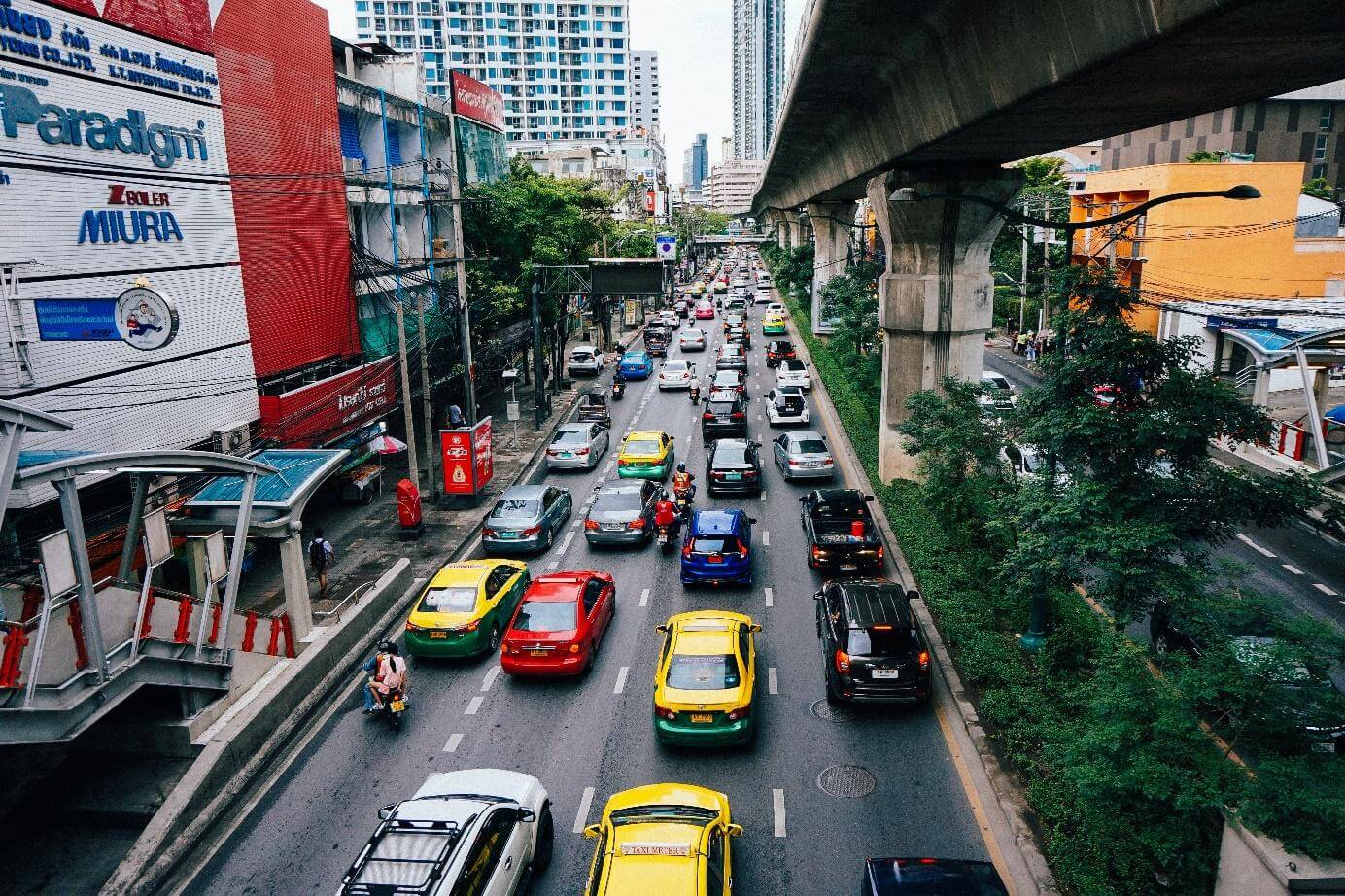
What is the situation at the European level? According to a report by the Federal Statistical Office, annual CO2 emissions from road traffic in the EU increased by 21% between 1990 and 2021. Cars are the biggest contributor to these emissions. Although vehicles have become more efficient and there are new fuels with lower emissions, this progress is being cancelled out by the increase in traffic volume and the increased use of high-powered vehicles with comparatively high fuel consumption.
In 2021, around 740 million tonnes of carbon dioxide (CO2) were emitted in the EU through the combustion of fuels in road traffic. Passenger cars and motorbikes accounted for 64% of this, lorries and buses for 27% and light commercial vehicles for a further 10%. It is clear that the greatest potential for reducing emissions lies in the passenger car category, and therefore in private transport.
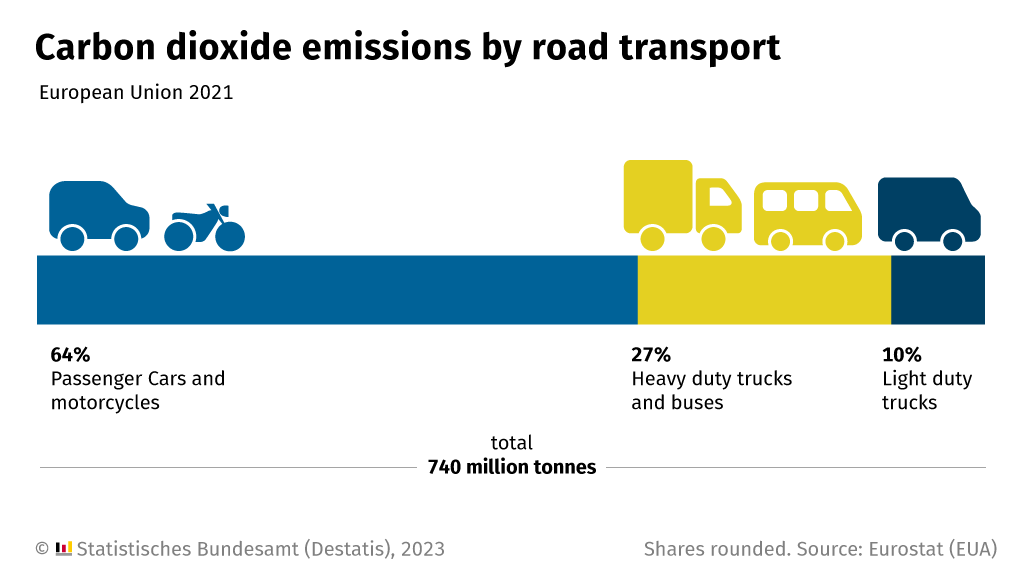
Are electric cars the solution for a clean transport sector?
In recent years, the electric car (e-car) has established itself as a promising option for reducing CO2 emissions in car traffic. It has attracted public attention because it runs without petrol and therefore has no direct pollutant emissions from combustion. It is possible that in the future, city centres will only be accessible to electric cars and will replace combustion engines. But is the electric car the solution for a clean transport sector?
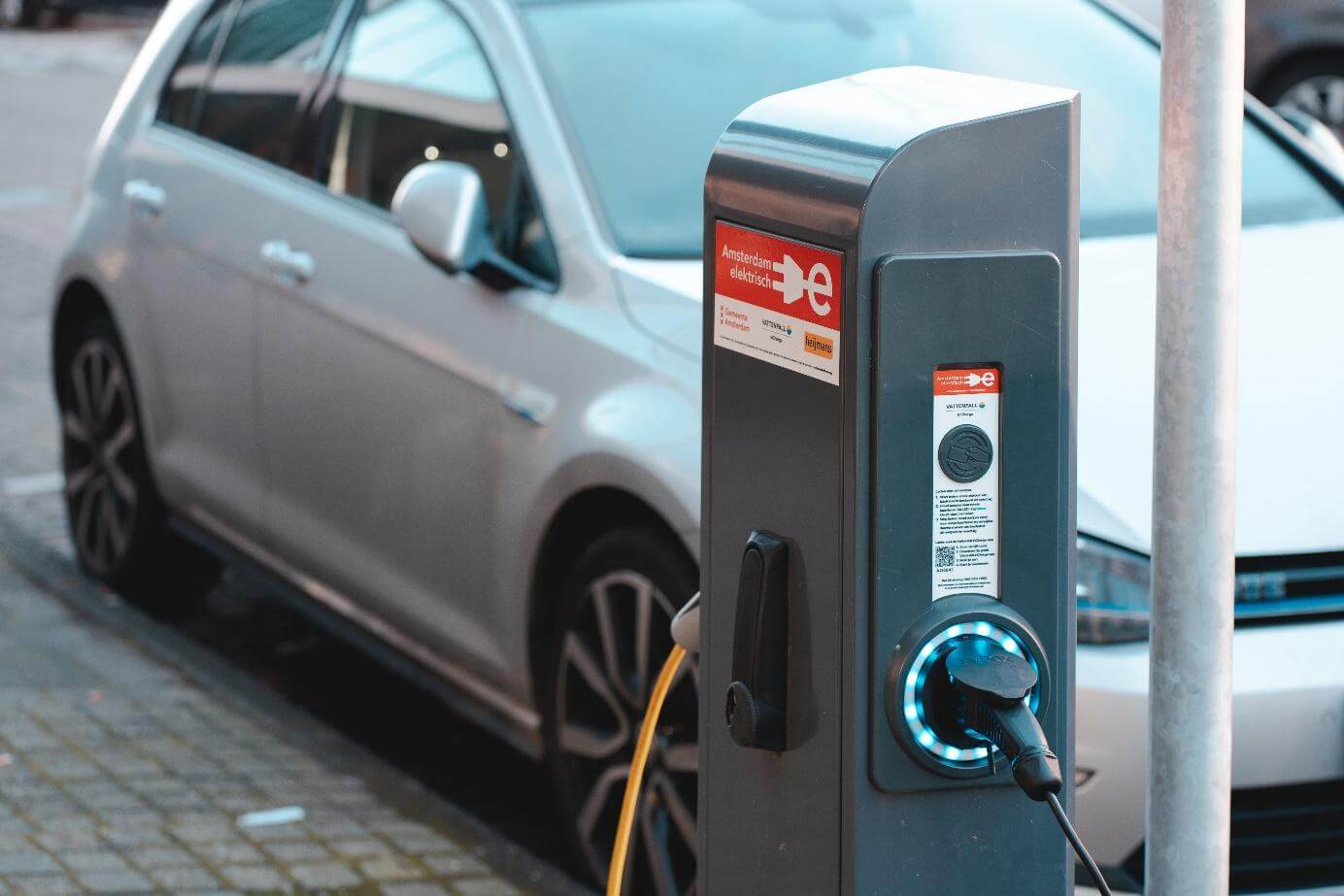
The answer to this question is complicated. As already explained, the negative effects of the transport sector are mainly twofold. Firstly, there is fine dust, which can lead directly to health problems. Secondly, there are the greenhouse gases that drive climate change. E-cars can certainly contribute to an improvement in both aspects. However, it is crucial how the electricity that powers the electric cars is generated. If this electricity comes from coal and natural gas power plants, which are still widely used in Germany, the environmental impact is limited. In this scenario, electric cars would mainly contribute to relieving the burden locally, while the environmental problems at the power plants would continue to exist. However, if the introduction of electric cars is accompanied by increased use of renewable energies, such as green electricity, the balance looks much better. Switching to renewable energies is crucial to fully utilise the benefits of electromobility and achieve the cleanest possible transport sector.
Another important aspect that must be taken into account when assessing electric cars is the production process, especially the battery production. Batteries have high production emissions, which primarily affects the regions in which most batteries are manufactured. According to the statistics portal “Statista”, the focus of battery production is currently in Asia, although production capacities in Europe are set to increase significantly in the coming years. The amount of CO2 in production correlates strongly with the capacity of the battery. As a result, production is so CO2-intensive that a new electric car has a worse carbon footprint than a combustion engine that has just left the factory.
Does this mean that electric cars are a bad idea? No, because the decisive factor is the CO2 emissions over the entire life cycle of the vehicle. A study by the ADAC found that an electric vehicle has a climate advantage over a combustion engine after 45,000 to 60,000 kilometres. Depending on the driving style, this can take around 3 to 5 years. With green electricity, this threshold is 25,000 to 30,000 kilometres. Overall, electric cars are more climate-friendly than combustion engines, which is also confirmed by the life cycle analysis tool from Transport & Environment (T&E). The tool compared worst-case and best-case scenarios for the carbon footprint of electric cars with that of combustion engines. In the worst-case scenario, the battery comes from China, the country with the highest production emissions, and the electric car is driven in Poland, the country with the most polluting power supply. Here, the e-car has a CO2 reduction of 37%. In the best-case scenario, the battery is manufactured in Sweden and the electric car is also driven in Sweden. In this case, the reduction is 83%. E-cars can therefore clearly contribute to reducing CO2, but they cannot completely eliminate emissions.
In regard to fine dust, although e-cars do not cause any emissions through the combustion of exhaust gases, they also generate brake and tyre wear as well as dust particles swirled up from the road. In addition, fine dust emissions can occur during electricity generation or production. To summarise, it can be said that electric cars are a better alternative to combustion engines when their entire life cycle is considered, but they cannot make the transport sector completely emission-free.
How should mobility develop in times of climate change?
This raises the question of how mobility should develop in times of climate change and air pollution. It is clear that promoting individual transport cannot be the most environmentally friendly solution. If many vehicles continue to travel with only one person on the road, the transport sector will continue to contribute to air pollution, even if the vehicles are mainly electric and powered by green electricity. These vehicles still produce fine dust through their brakes and tyres and have a resource-intensive production process that causes emissions.
Instead, environmentally friendly mobility concepts are needed that rely on public transport, carpooling and cycling. The Federal Environment Agency has presented an exemplary concept called ‘The City of Tomorrow‘.

In this city of the future, only electric vehicles that are smaller and adapted to urban use will be driven in the city centre areas. All public transport is electric and powered by green electricity. The concept of ‘using instead of owning’ is at the forefront to ensure that existing vehicles are used as efficiently as possible. This includes electric car sharing and comprehensive bicycle rental systems. Thanks to the more efficient use of existing vehicles, there are significantly fewer cars in the city than today. This creates more living space instead of car parking spaces and promotes environmentally friendly mobility with less congestion and more movement. Of course, this is easier said than done, as it will be important for the population to get to their destination quickly and conveniently. Ideally, such a system should therefore function perfectly. Nevertheless, it is important to consider such concepts as guiding principles in order to create a future that is as clean and low-emission as possible.
